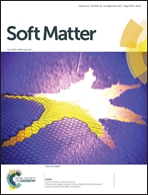From a silane monomer to anisotropic buckled silica nanospheres: a polymer-mediated, solvent-free and one-pot synthesis†
Abstract
The morphology of particles, along with other particle attributes, has been shown to affect the biological fate of particles administered into the body. Particles with collapsed surfaces or shells (dimpled, buckled or crumpled) can have different appearances, under the microscope, that resemble many things encountered in our daily life, such as apples/cherries, doughnuts, and bowls. Recent studies have demonstrated that they are not just particles with interesting geometries, but they can also be used as functional blocks for assembled complex materials. Since previous research focus has been on micron-sized particles and organic solvents were often used, it is of particular interest to synthesize the nanosized counterpart with a buckled surface using a purely aqueous method. Herein we report a facile method for rapid synthesis of buckled silica nanoparticles (SiNPs) based on S-nitrosothiol chemistry in a solvent-free reaction. 3-Mercaptopropyl trimethoxysilane (MPTMS) was used as a single silane source in a one-pot aqueous solution containing sodium nitrite and polyvinyl alcohol (PVA). Upon the addition of HCl, S-nitrosation and condensation of MPTMS occur simultaneously and the reaction system undergoes a rapid transition from a clear solution to a solution containing nanoparticles with a lag time controlled mainly by the amount of HCl added. The experimental parameters were systematically studied to determine the optimal concentration of each component. For a typical reaction, sub-100 nm nanoparticles can be produced in less than 1 h, and the best result can be obtained within 2 to 4 h. Remarkably, the nanoparticle exhibits buckled surface morphologies under TEM and SEM. The average size is about 60 nm in diameter. Moreover, the solid-state Si-NMR data show that T2 and T3 silicon species are rapidly evolved with slight dynamic changes over the reaction time. Further, PVA is shown to control the surface buckling as well as to stabilize the formed particles. The as-prepared SiNPs can be used as a nitric oxide (NO) carrier with the potential to release NO in an apparent zero-order manner. In conclusion, the study demonstrates the feasibility of employing an aqueous route for efficiently preparing SiNPs with multifarious surface cavities based on S-nitrosothiol chemistry.



 Please wait while we load your content...
Please wait while we load your content...